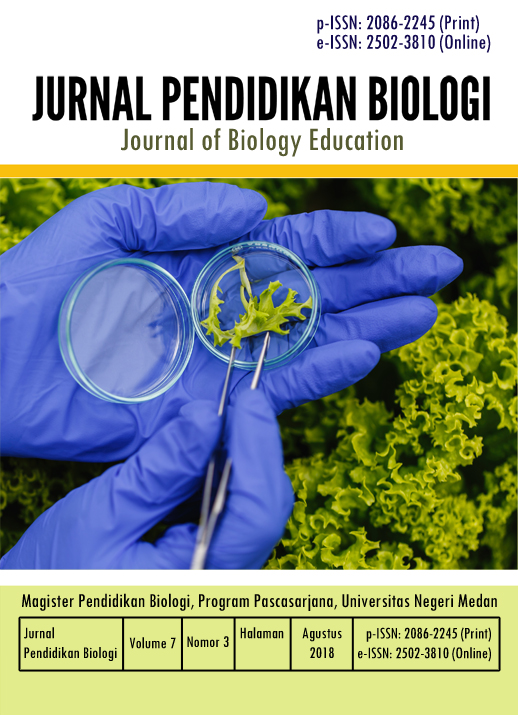Penerapan Pembelajaran Problem Based Learning Berbasis Blended Learning terhadap Hasil Belajar Kognitif dan Motivasi Mahasiswa
DOI:
https://doi.org/10.24114/jpb.v7i3.10433Abstract
Learning innovation in Higher Education with a scientific approach based learning has been integrated with Information and Communication Technology. This encourages students to solve problems in accordance with the real conditions in the surrounding environment. In addition, it can create self-reliance and learning motivation for students to learn science without any time and place limitation. This study aims to implement scientific approach based learning through the Problem Based Learning model based on Blended Learning in Animal Ecology subjects. This research method is Quasi Experimental Design with Non Equivalent Control Group Pretest-Posttest Design in Experimental groups through combined Problem Based Learning. Blended Learning. The sample of this research is Biology Education students of FKIP Universitas Samudra. The research instrument used cognitive tests in the form of Essay questions and ARCS motivation questionnaires. Qualitative data analysis by testing Validity and Reliability. Hypothesis testing with the prerequisite test for data normality and paired t sample t test. The results of the study obtained the value of t arithmetic = 13.61 or with Sig (2-tailed) (0.00) α α (0.05) thus Ha was accepted that the significant cognitive learning outcomes of students occurred through learning Blended Learning-based Problem Based Learning. Student learning motivation is categorized into three: very high, high, and medium. The percentage of students in the three categories is 30%, 63.33%, and 7% respectively.References
Arends, R. (2008). Learning to Teach. Penerjemah: Helly P dan Sri M. New York: McGraw Hill Company.
Borg, W., & Gall, M. (1983). Educational Research an Introduction. New York and London: Logman
Facione, P. (2013). Critical Thinking: What It Is and Why It Counts. California: Measured Reason and The California Academic Press.
Fry, H., Steve, K., & Stephanie, M. (2009). The Handbook for Teaching and Learning in Higher Education. New York dan London: Routledge.
Kintul, M. K., Zhu, C., & Edmond, K. (2017). Blended learning effectiveness: the relationship between student characteristics, design features and outcomes. International Journal of Educational Technology in Higher Education, 14 (7), hlm. 2-20.
Kistow, B. (2011). Blended learning in higher education: A study of a graduate school of business, Trinidad and Tobago. Caribbean Teaching Scholar, 1 (2), hlm. 115-128.
Munasir & Anshori, S. (2010). Pengintegrasian Problem Bassed Learning dan Pendekatan Group Investigation. Jurnal Kependidikan Interaksi, 5 (5), hlm. 1-9.
National Science Teachers Association. 2006. Induction Programs for the Support and Development of Beginning Teachers
Ngana, O., Tangb, T., Chanc, A., Daisy, M., & Mei K. (2017). Blended Learning in Anatomy Teaching for Non-Medical Students: An Innovative Approach to the Health Professions Education. Journal Health Professions Education, 4 (1), hlm. 149-158.
Perez, V., Lopez, M., & Lazoro, R. (2011). Blended learning in higher education: Students perceptions and their relation to outcomes. Journal Computers and Education, 56 (1), hlm. 818-826.
Ramakrisnana, P., Yahya, Y., M. Nor, H., & Azlan. (2012). Blended Learning: A Suitable Framework For E-Learning In Higher Education. Procedia - Social and Behavioral Sciences. The 3rd International Conference on e-Learning ICEL 2011 (hlm. 513-526) Bandung: UPI
Sailah, I., Tresna, D. K., I Made, S., SP Mursid., Endrotomo., Sylvi, D., Syamsul, A., Liliana S., Ludfi, D., Jumhur., Sri P., Lien, H., Henny, K., Emmy, H., Ridwan, R. T., Evawany & Nafiron, M. (2014). Buku Kurikulum Pendidikan Tinggi. Jakarta: Direktorat Pembelajaran dan Kemahasiswaan, Direktorat Jendral Pendidikan Tinggi, Kementrian Pendidikan dan Kebudayaan
Sarıtepeci, M., & Cakir, H. (2015). The Effect of Blended Learning Environments on Student's Academic Achievement and Student Engagement: A Study on Social Studies Course. Journal Education and Science, 4 (177), hlm. 203-216.
Savery, J., & Duffy, T. (2001). Problem Based Learning: An instructional model and its constructivist framework. CRLT Technical Report, 16 (01), hlm. 77-81.
Savery, J. (2006). Overview of Problem-based Learning: Definitions and Distinctions. The Interdisciplinary Journal of Problem-based Learning, 1 (1), hlm. 9-20.
Schunk, D. (2012). Learning Theories An Educational Perspective. Boston: Pearson Education, Inc.
Semerci, N. (2006). The Effect of Problem-Based Learning on The Critical Thinking of Students In The Intellectual and Ethical Development Unit.
Slavin, R. (2006). Educational Psycology: Theory and Practice. Boston: Pearson Education, Inc.
Simone. (2014). Problem-Based Learning in Teacher Education. International Journal of Humanities and Social Science, 4 (12), hlm. 54-62
Sudarman. (2007). Problem Based Learning: Model Pembelajaran untuk Mengem-bangkan dan Meningkatkan Kemampuan Memecahkan Masalah. Jurnal Pendidikan Inovatif, 2 (2), hlm. 68-73.
Suwono, H. (2013). Aktivitas belajar mahasiswa calon guru Melalui penerapan Blended Learning Menggunakan website berbasis moodle. Prosiding Seminar Nasional Biologi IPA 2013 (hlm.153-160. Surabaya: UNESA.
Yamin. (2006). Strategi Pembelajaran Berbasis Kompetensi. Jakarta : Gaung Persada Pers
Yustina. (2016). Pemikiran Kreatif dan Pemahaman Konsep Mahasiswa Pendidikan Biologi dalam Pembelajaran IPA Melalui Problem Based Learning (PBL). Prosiding SEMIRATA Bidang MIPA 2016 (hlm. 231-233) Palembang: UNSRI.
Downloads
Published
Issue
Section
License
Copyright
Penyerahan naskah menyiratkan bahwa karya yang diserahkan belum pernah diterbitkan sebelumnya (kecuali sebagai bagian dari tesis, laporan, atau abstrak). Naskah tidak dipertimbangkan untuk publikasi di tempat lain. Penerbitannya telah disetujui oleh semua penulis bersama. Jika dan kapan naskah diterima untuk publikasi, penulis masih memegang hak cipta dan mempertahankan hak penerbitan tanpa batasan. Penulis atau orang lain diperbolehkan untuk melipatgandakan artikel selama tidak untuk tujuan komersial. Untuk penemuan baru, penulis disarankan untuk mengelola patennya sebelum diterbitkan.
Open Access
Jurnal ini berkomitmen untuk membuka akses bebas yang tidak membebankan biaya kepada pembacanya atau lembaga mereka. Pembaca berhak membaca, mengunduh, menyalin, mendistribusikan, mencetak, mencari, atau menautkan ke teks lengkap artikel, selama tidak untuk tujuan komersial. Jenis lisensi adalah CC-BY-4.0.
Disclaimer
Tidak ada tanggung jawab yang dikenakan kepada Penerbit atau oleh editor untuk kesalahan dan/atau kerusakan pada naskah sebagai akibat dari pernyataan pencemaran nama baik atau dugaan pencemaran nama baik, pelanggaran hak kekayaan intelektual atau privasi, atau kewajiban produk, baik akibat kelalaian atau sebaliknya, atau dari penggunaan atau operasi ide, instruksi, prosedur, produk atau metode apa pun yang terkandung dalam materi di dalamnya.

